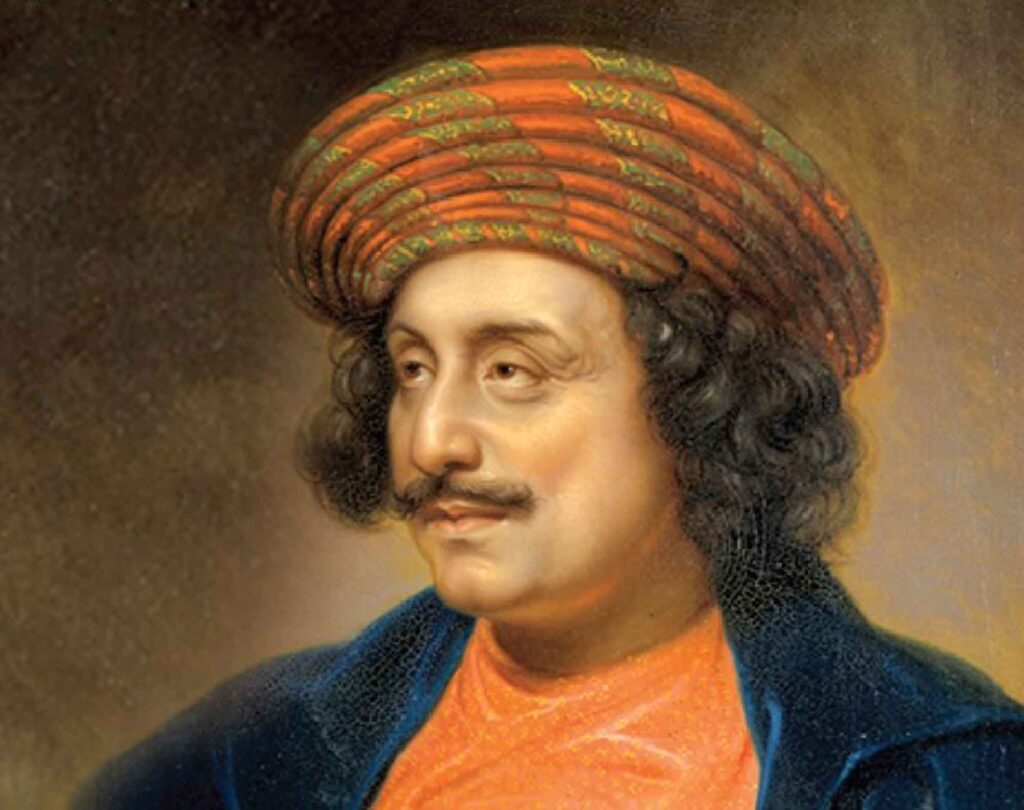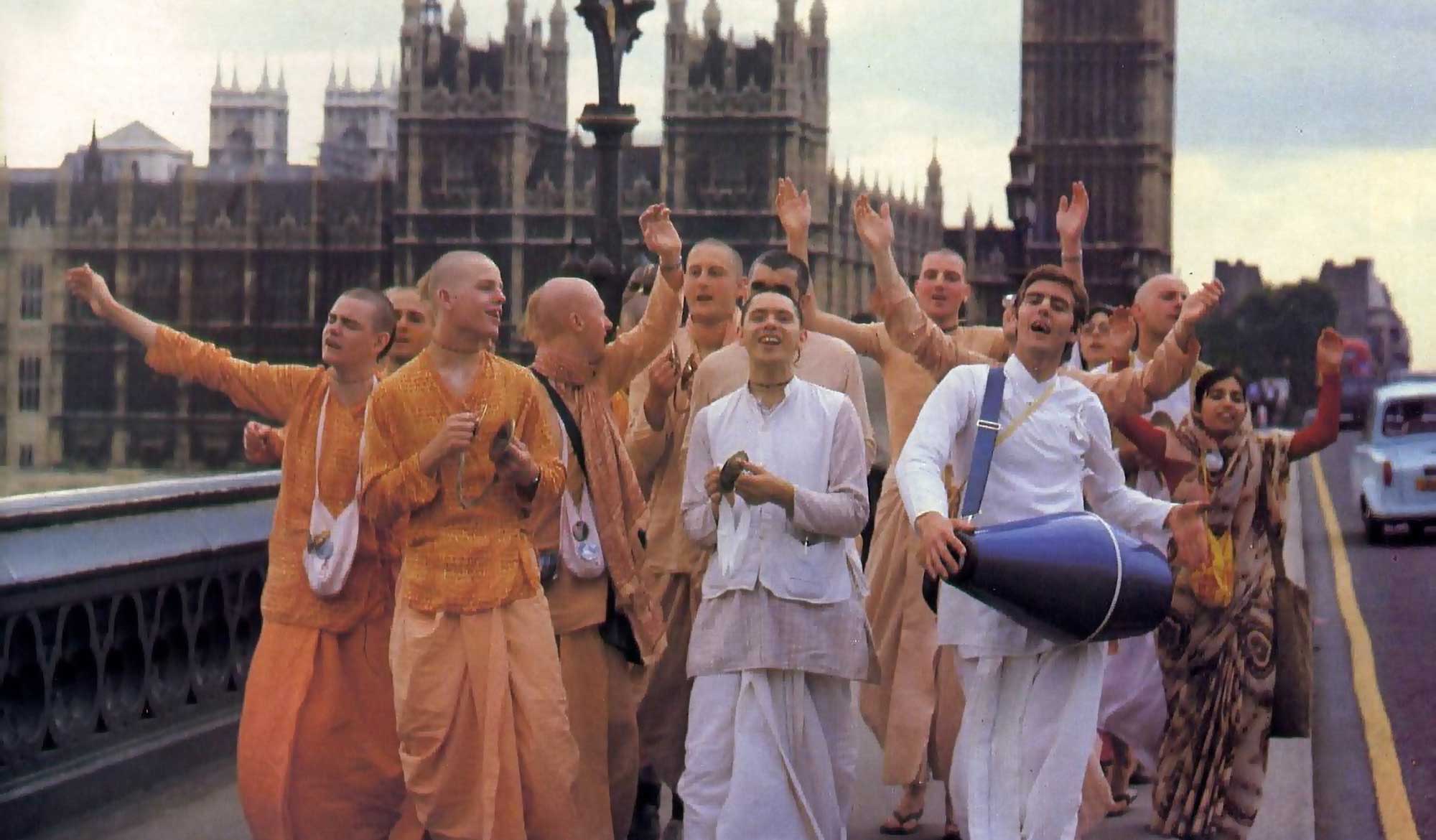Overview
‘Śrī Māna Sarovara’ was first published by Bhaktivinoda Ṭhākura in Sajjana Toṣaṇī Vol.4. issue 3 in 1892. In this article, he briefly describes the holy place of Māna Sarovara in Vraja, and then narrates the story of Harivaṁśa Gosvāmī, the disciple of Gopāla Bhaṭṭa Gosvāmī, and his murder at the hands of thieves.
(translated by Swami B.V. Giri)
Śrī Māna Sarovara is about two krośas (2.6 miles) from Śrī Vṛndāvana, crossing Śrī Yamunā. Research reveals that long ago, there was no Yamunā between Māna Sarovara and Vṛndāvana. At some point, the course of Yamunā Devī has changed and separated Vṛndāvana in Māna Sarovara. Rumour has it that in the rāsa-maṇḍala of Śrī Vṛndāvana, when Śrīmatī was haughty (māna), She sat at Māna Sarovara. Since then, Māna Sarovara has become a major premamaya-tīrtha (a holy place abounding with prema). Since then, there is ghāṭa with a paved barrier at the sarovara, the temple of Śrī Priyājī nearby, a couple of samādhis, a maṇḍapa the size of ten hands, and a beautiful garden belonging to the Vallabha Bhaṭṭa sampradāya. Śrī Beharījī exists in a lofty palace nearby. Śrī Harivaṁśa Gosvāmī, a disciple of Śrī Gopāla Bhaṭṭa Gosvāmī, used to live at this Māna Sarovara. The tīrtha of Māna Sarovara is presently under the auspices of the Vaiṣṇavas of the Rādhā-Vallabhī sampradāya founded by him.
Many may wish to know the history of this sampradāya since many people belonging to the Bardhaman district have been disciples of this sampradāya. The king of Bardhaman is one of them. Śrī Harivaṁśa Gosvāmī is the main ācārya of the Śrī Rādhā-Vallabhī sampradāya. He was born in an obscure village near Agra. At a young age, he was attracted to prema of the Divine Couple, Śrī Rādhā-Kṛṣṇa, and took shelter at the feet of Śrīmad Gopāla Bhaṭṭa Gosvāmī in Śrī Vṛndāvana. Harivaṁśa Gosvāmī does not seem to have been a scholar of the Sanskrit language. He was easily free from the restraints of scholarship. Having attained a few instructions, Śrī Harivaṁśa built a temple for bhajana at Māna Sarovara and lived there surrounded by many loyal disciples. Instead of engaging in the specific sixty-four aṅgas of bhakti as given by the Gosvāmīs, he and his disciples began to do bhajana only by singing rāga-mārga songs. Thus, Śrīmad Gopāla Bhaṭṭa Gosvāmī gradually learned about this. However, Harivaṁśa sometimes used to visit the temple of Śrī Rādhā-Ramaṇa at Śrī Vṛndāvana to pay obeisance to the feet of his Gurudeva.
There is a story that on Ekādaśī day, while chewing tāmbūla (betel-nut), he came to the feet of his guru and offered daṇḍavats. Bhaṭṭa Gosvāmī was a little surprised and asked Harivaṁśa, “What is this behaviour? Are you chewing tāmbūla on Hari-vasara?” With a humble demeanor, Harivaṁśa pleaded, “Prabhu! Śrī Priyājī has given me this prasādī–tāmbūla.” Bhaṭṭa Gosvāmī said, “The world will see this behaviour in regards to your attachment and all unqualified jīvas will become degraded by you. Therefore, from today you are cast out from our sampradāya!” Harivaṁśa was sad and returned to Māna Sarovara. That very day, an unknown thief cut off his head in the middle of the night and threw it into Bhaṭṭa Gosvāmī ghāṭa on the Yamunā. Bhaṭṭa Gosvāmī would go to the Yamunā ghāṭa to perform his morning rituals, and seeing the severed head, he became extremely sad. At his command, the head was buried. Even today, Śrī Priyājī has been established over this community in the Śrī Rādhā-Vallabhī rāsa-maṇḍala. I have also heard that Harivaṁśa’s body is buried on the banks of Māna Sarovara.
I have heard this history from many people in many ways, and we have written down whatever seemed to be connected with it. Some people say that Gopāla Bhaṭṭa Prabhu’s curse fell on the head of Harivaṁśa. This is absolutely not worth listening to. Why would a mahā-puruṣa such as Śrīmad Gopāla Bhaṭṭa Gosvāmī Prabhu deliver such a terrible curse to Śrī Harivaṁśa? We have written as if beheading by thieves was commonly accepted, but we also have many doubts about this. Why would thieves decapitate a bhajanānandī Vaiṣṇava? Especially when Śrī Harivaṁśa was a niśkiñcana Vaiṣṇava (a devotee who owns nothing). There was no reason for robbers to come to him. Again, what was the need for the robbers to throw the severed head at Bhaṭṭa Gosvāmī’s ghāṭa which was two krośas distance from Māna Sarovara? The more this issue is discussed, the sadder it becomes. It is feared that there may have been a villain amongst the many gentlemen loyal to Bhaṭṭa Gosvāmī, and that horrible act was executed by his indiscretion. Neither Śrī Bhaṭṭa Gosvāmī nor the gentle Vaiṣṇavas following him knew anything about it, and no further inquiries were made.
However, there is no doubt that Śrī Harivaṁśa Gosvāmī was a true Vaiṣṇava who followed the path of rāgānugā-bhakti. There are many signs of pure devotion in the book, Chorāśī-pada. The Vaiṣṇavas that follow him recite the verses of Sura Dāsa every day. Śrī Gaurāṅga is not recognised in the Śrī Rādhā-Vallabhīya sampradāya. It must be understood that they are not counted amongst the four Vaiṣṇava sampradāyas. Their sampradāya is stemming from Śrī Harivaṁśa. In their kīrtanas, they chant that Śrī Priyājī is their original guru. In this sampradāya, there is no respect given to rules or the maryāda-mārga (the path of proper etiquette). Discussing all this, it is clear that the Gosvāmī sampradāya was not satisfied with the Harivaṁśa sampradāya. Although the Gosvāmīs respected Harivaṁśa’s anurāga (attachment), they did not respect his utter contempt towards vaidhi-bhakti. For this reason, Śrī Harivaṁśa had to face misfortune. We don’t know much about this. If anyone knows the true details about this, then it is our prayer that they write an article and publish it in the Sajjana Toṣaṇī.













